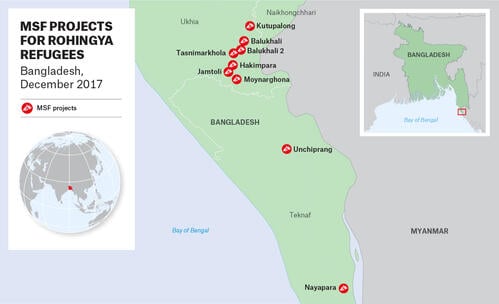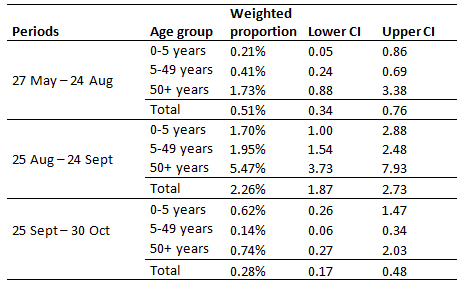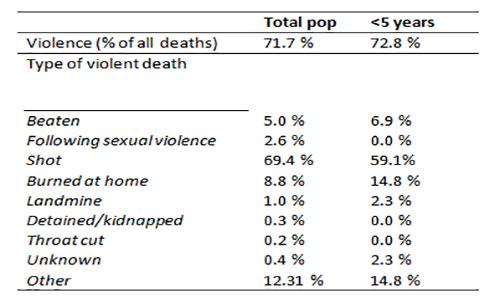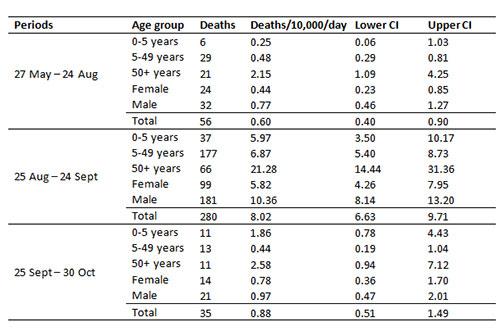Background
On 25 August 2017, a counter-insurgency military operation in Rakhine State, Myanmar, led to a mass displacement of Rohingya civilians into Bangladesh. Over the following three months, some 626,000 Rohingya crossed into Bangladesh to escape the violence.
To assess the scale of the emergency and the needs for humanitarian assistance, Médecins Sans Frontières (MSF) conducted six surveys to estimate the retrospective mortality of the population residing in Kutupalong, Balukhali and Tasnimarkhola settlements in Cox’s Bazar district, Bangladesh. The surveys targeted a total estimated population of 608,108, 82.8% of whom were “newly-displaced” from Myanmar, i.e. had arrived after 25 August 2017.

Methods
In November 2017, MSF conducted six retrospective surveys among the Rohingya population in Bangladesh. Four surveys were carried out in the northern settlements (in Kutupalong makeshift settlement, Balukhali makeshift settlement and in the extensions of these settlements), covering an estimated population of 367,718. A further two surveys were carried out in the southern settlements (in Balukhali 2 and Tasnimarkhola settlements), covering approximately 135,980 people. In the north, the survey team used simple random sampling, with a sample size of 905 households; in the south, systemic sampling was used, with a sample size of 1,529 households. In total, survey teams conducted interviews with 2,434 households (representing 11,426 people). The recall period for the surveys covered roughly equal time periods before and after 25 August 2017, beginning on 27 May 2017 and ending on 30 October 2017. Heads of households described the family structure and provided the date, location and cause of death of family members who died during the recall period. To pool the collective survey results, MSF performed a weighted analysis using the relative population estimates for each survey’s catchment area.
Results
These surveys are representative of 503,698 Rohingya who arrived from Myanmar’s Rakhine State during the recent mass displacements, and 104,410 Rohingya already living in the settlements in Bangladesh prior to 25 August 2017. Some 626,000 Rohingya are estimated to have arrived in Bangladesh since 25 August, and therefore the MSF surveys represent 80.4% of the total newly-arrived population in Bangladesh from Myanmar.
Deaths that are reported to have occurred during the first month of the crisis (25 August to 24 September 2017) represent 2.26% of the total population [95% CI: 1.87 – 2.73%], with 2.83% [95% CI: 2.23 – 3.59%] of deaths in the male and 1.69% [95 CI: 1.24 – 2.30%] of deaths in the female population at that time (Table 1).

Violence was the direct cause of death for the majority (71.7%) of Rohingya who died from 25 August to 24 September 2017. Cause of death by shooting accounted for 69.4% of these deaths; being “burned to death at home” accounted for 8.8%; being beaten to death accounted for 5.0%; sexual violence leading to death for 2.6%; and death by landmine for 1.0% (summary in Table 2).
Children were not spared this violence: a total of 1.70% [95% CI: 1.00 – 2.88%] of the population under five years of age died during this period, with 72.8% of those deaths due to direct violence, including shooting (59.1%), being “burned to death at home” (14.8%), being beaten (6.9%), and being killed by landmines (2.3%) (summary in Table 2).

Expressed in mortality rates per 10,000 per day (Table 3), our data shows an exceedingly high level of mortality, with a pooled crude mortality rate (CMR) of 8.02 deaths/10,000/day [95% CI: 6.63 – 9.71] in the 31 days following 25 August 2017. This mortality rate is 13.3 times higher than the pooled CMR for the same population prior to the start of the crisis (for the period 27 May to 24 August 2017) and 9.2 times higher than the pooled CMR for the same population after the initial 31 days of the crisis (for the period 25 September to 30 October 2017).
The pooled under-five mortality rate (U5MR) was 5.97 deaths/10,000/day [95% CI: 3.50 – 10.17] during the 31 days following 25 August. This rate is 23.9 times higher than the pooled U5MR for the same population prior to this period (27 May to 24 August 2017) and 3.2 times higher than the pooled U5MR for the same population after the initial 31 days of the crisis (25 September to 30 October 2017).
For this same period (25 August to 24 September 2017), the pooled mortality rate for the population ≥50 years old was 21.28 deaths/10,000/day [95% CI: 14.44 – 31.36]. This mortality rate is 9.9 times higher than the pooled mortality rate for the same population prior to this period (27 May to 24 August 2017) and 8.2 times higher than the pooled mortality rate for the same population after the initial 31 days of the crisis (25 September to 30 October 2017).

Conclusion
If we apply these proportions to the total newly-arrived population in the surveyed camps, an estimated 11,393 people died [95% CI: 9,425 – 13,759] in Myanmar’s Rakhine State in the initial 31 days following the upsurge of violence on 25 August 2017, including 1,713 children under five years of age [95% CI: 1,008 – 2,896]. Of these, 8,170 deaths were due to violence [95% CI: 6,759 – 9,867], including 1,247 children under five years of age [95% CI: 734 – 2,109].
These surveys provide epidemiological evidence of high rates of mortality among the Rohingya population due to violence, and suggest that they faced mass killings prior to their arrival in Bangladesh. Additionally, the rates of mortality captured here are likely to be underestimates, as the data does not account for those people who have not yet been able to flee Myanmar, or for families who were killed in their entirety.


